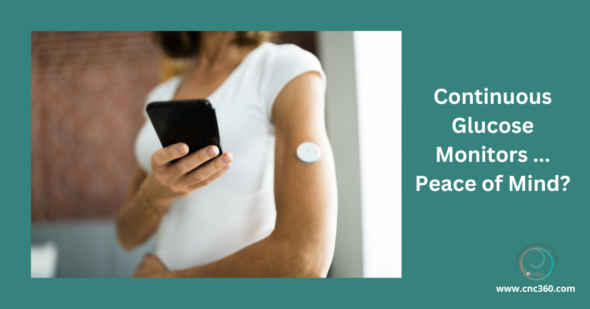Continuous glucose monitors (CGM) can be used as a tool to support positive self-care.
According to a recent study, 90% of respondents with diabetes who used CGM reported that it contributed to a healthier lifestyle. In addition, CGM impacted lifestyle. Forty-seven percent of respondents reported they were more likely to go for a walk if using CGM and noted a rise in glucose, and 87% of CGM uses modified food choices based on CGM feedback.1
Less research is available about how people without diabetes interact with a CGM and how this impacts self-care behaviors or their relationship with food and body. For someone without diabetes, a steep rise in glucose after eating may feel alarming. This can be a valuable important opportunity to lean into body trust, and to recognize that the rise in glucose will lead to a signal for the body to produce the necessary insulin to bring the glucose down to target levels.

It is also important to recognize that if a meal results in a sharp rise in glucose, it could be due to a number of factors including earlier meals, portion, what else was in the meal, and the way the food was prepared. This can vary from day to day, and it is important to check-in about any food rules or rigidity around food choices that you notice emerging while using a CGM. The CGM may help to understand why you feel tired or hungry or shaking after eating and can lead to a constructive conversation with your dietitian around organizing meals and snacks that lead to a sense of body confidence and satisfaction after eating.
The question of how often someone plans to interact with their CGM is important to discuss.
The purpose of the technology is to guide self-care decisions (food, activity, medication) and to ease the time and attention diabetes or glucose management takes up in one’s life. It serves as a safeguard to alarm if glucose deviates from target range.
The CGM can inform someone about the impact of physical activity and food choices on glucose levels, and this can bolster trust and predictability in understanding how the body will respond to each of these.
There are times when you and your healthcare team determine it is time to discontinue use of a CGM.
Such circumstances may include:
- CGM Data patterns or device-checking feels unbalanced and becomes very frequent, and starts to take away time and attention from other activities you enjoy or need to attend to. This might look like having a conversation with a friend whilst checking a glucose that is in normal range several times, with thoughts consumed by concern of an impending glucose rise or fall.
- CGM Data is generating new rules that lead to rigidity and restrictions around eating, food, activity and relationship with your body.
- The financial (price of the device) or physical (potential skin reactions) costs outweigh the benefits.
- Alarms or alarm fatigue impacts your response to the device notifications or brings conflict between you and your support people. This may signal the need to discuss what is leading to the alarms and if your healthcare team is on board, adjust the alarm thresholds or use of the CGM.
If you decide to use continuous glucose monitors as a tool to care for your health, work with a professional team who understands how to promote and preserve a healthy relationship with food and your body. You can feel free to reach out to us.
1Ehrhardt N, Al Zaghal E. Continuous Glucose Monitoring As a Behavior Modification Tool. Clin Diabetes. 2020 Apr;38(2):126-131.
